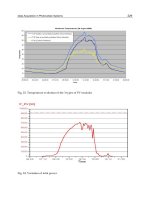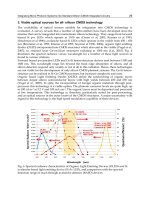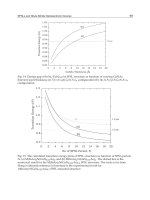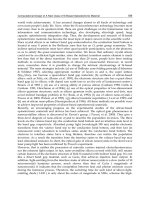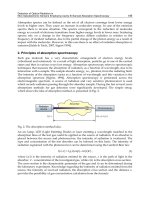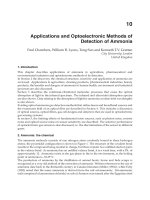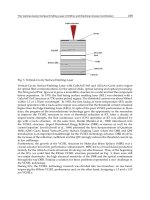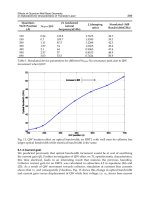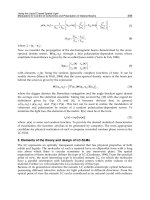Optoelectronics Devices and Applications Part 7 potx
Bạn đang xem bản rút gọn của tài liệu. Xem và tải ngay bản đầy đủ của tài liệu tại đây (3.15 MB, 40 trang )
The Vertical-Cavity Surface Emitting Laser (VCSEL) and Electrical Access Contribution 3
Fig. 3. Vertical-Cavity Surface-Emitting Laser
Vertical-Cavity Surface-Emitting Laser with GaInAsP/InP and AlGaAs/GaAs active region
for optical fiber communications, for the optical disks, optical sensing and optical processing.
The first goal of Prof. Iga was to grow a monolithic structure in a wafer and test the component
before separation. In 1979, the first lasing surface emitting laser (SEL) was obtained with a
GaInAsP/InP structure at 77K under pulsed regime. The threshold current was about 900mA
within 1.3 or 1.55μm wavelength. In 1983, the first lasing at room temperature (RT) under
pulsed operation with a GaAs active region was achieved but the threshold current remained
higher than the Edge Emitting Laser (EEL)). In spite of the poor VCSEL performance in those
days, the progress of the microelectronic technology gave the opportunity to the researcher
to improve the VCSEL structure in view of threshold reduction at RT. After a decade of
improvement attempts, the first continuous wave (CW) operation at RT was obtained by
Iga with a GaAs structure. At the same time, Ibariki (Ibaraki et al., 1989) introduced, into
the VCSEL structure, doped Distributed Bragg Reflector (DBR) as mirrors as well for the
current injection. Jewell (Jewell et al., 1989) presented the first characterisation of Quantum
Wells (QW) GaAs Based Vertical-Cavity Surface Emitting Laser where the DBR and QW
introduction is an important breakthrough for the VCSEL technology advance: DBR involves
the increase of the reflection coefficient and the QW strongly reduces the threshold current up
to few milliamps.
Furthermore, the growth of the VCSEL structure by Molecular Beam Epitaxy (MBE) was a
crucial advance toward its performance enhancement. MBE led to a broad-based production
(mainly for the AlGaAs/GaAs structure) involving cost effectiveness. Thus, at the beginning
of the 90’s, we could find the 850nm VCSEL structure presented on Fig. 3, there were still
two major drawbacks: the high electrical resistivity of the DBR and the optical confinement
through the top DBR. Finding a solution for these problems represented a new challenge in
the VCSEL technology.
During 90’s, the VCSEL technology research was divided into two branches: on one hand,
improving the 850nm VCSEL performance and, on the other hand, designing a 1.3 and a 1.55
μm VCSELs.
229
The Vertical-Cavity Surface Emitting Laser (VCSEL) and Electrical Access Contribution
4 Will-be-set-by-IN-TECH
Fig. 4. Various doping profile of Al
x
Ga
1−x
As
Fig. 5. Mesa structure
2.2 850nm VCSEL
(a) (b)
Fig. 6. (a) Proton implanted VCSEL, (b) Oxide confined VCSEL
230
Optoelectronics – Devices and Applications
The Vertical-Cavity Surface Emitting Laser (VCSEL) and Electrical Access Contribution 5
Before attaining the maturity of the 850nm VCSEL technology numerous research works have
been carried-out. Firstly, the resistivity of the DBR has been reduced by modifying the doping
profile of Al
x
Ga
1−x
As (Kopf et al., 1992). Fig. 4 shows different doping profiles. The first
VCSEL generations had an abrupt doping profile providing a good reflectivity but a high
resistivity (
> 100Ω). By modifying the doping profile at each AlGaAs/GaAs junction, the best
compromise between high reflectivity and low resistance has been obtained. The parabolic
profile (see fig.4) finally gave the best performance.
The current and photon confinements were other technological bottlenecks. Up to the day,
many GaAs-VCSEL structures were proposed. Structures presented on Fig.5 and 6 are the
most common. By using a MESA DBR, the optical confinement has been improved. This
technology allowed two possibilities for the top electrodes: on the top of the DBR (left
side of Fig.5) and closer to the cavity (right side of Fig.5). These structures provided good
performance but the technology is in disagreement to the broad-based production. The proton
implanted structure presented on the right side of Fig.6 is the first serial produced VCSEL.
The top DBR contains an insulating proton (H
+
) layer to limit the current spreading below
the top electrode. Nevertheless, this method doesn’t reduce enough the injection area to
avoid a transverse carrier spreading into the active layer (Zhang & Petermann, 1994). The
main consequence is a multimode transverse emission. Indeed, the coexistence of the optical
field and the current funnelling in the same area degrades the VCSEL operation. The oxide
confined structure Fig.6 provides a good compromise between the beam profile and high
optical power. Indeed, the diameter of the oxide aperture has an influence on the multimode
transverse behavior and the output power. If the oxide aperture diameter is smaller than 5μm,
the VCSEL has a singlemode transverse emission nonetheless the optical power is lower than
1mW. To obtain a high power VCSEL (about 40mW), the diameter of the oxide aperture has
to be wider (25μm) but the beam profile is strongly multimode transverse.
Another point to be emphasized for the use of the 850nm VCSEL is the thermal behavior. As
in any semiconductor, the carrier number is strongly dependent on the temperature, while
involving fluctuations of the optical power, the wavelength and threshold current (Scott et al.,
1993). The earmark of the VCSEL is the parabolic threshold current (I
th
) evolution close to
a temperature characteristic. If this characteristic of temperature is close to the ambiant, it
has the advantage of avoiding a thermal control for its applications. However the thermal
behavior degrades the carrier confinement due to the Joule effect through the DBRs and
modifies the refractive index of the DBR. These phenomena are responsible for the multimode
transverse emission and strong spatial hole burning.
By knowing these drawbacks, it is possible to consider the VCSEL as a median component
between good laser diodes and LED. Its low cost had allowed its emergence into the short
distance communication applications to increase the bit rate while keeping cost effectiveness.
2.3 1.3 and 1.55μm VCSEL
The emergence of the 1.3 and 1.55μm VCSELs was quite different than the 850nm ones. In fact,
the telecom wavelength laser market was widely filled by the DFB lasers whose performances
are well adapted to the telecom market. Bringing into the market, the LW-VCSEL, the
following assets have to be kept versus the DFB: high integration level and cost reduction
with relatively good performance. By considering the numerous bottlenecks of the LW-VCSEL
technology, it takes up a challenge. The first 1.3μm CW operation was demonstrated by Iga
(Baba et al., 1993),(Soda et al., 1983) in 1993 with an InGaAs/InP based active layer at 77K.
The upper mirror was constituted by 8.5 pairs of p-doped MgO-Si material with Au/Ni/Au
231
The Vertical-Cavity Surface Emitting Laser (VCSEL) and Electrical Access Contribution
6 Will-be-set-by-IN-TECH
layers at the top and 6 pairs of n-doped SiO/Si materials at the bottom. The materials given
a 1.3 and 1.5 μm wavelength are not compatible with a monolithic growth. To provide a
wavelength emission within 1.1 - 1.6 μm range, the most suitable semiconductor compound
is InGaAsP/InP. Even if the wavelength’s range is easy to reach, the InGaAsP/InP are not
well optimized for the DBR (Shau et al., 2004). Only 12-15 AlAs/AlGaAs pairs are needed
to fabricate a DBR with 99% reflectivity. By taking into account a low refractive index
difference (0.3) between InP/InGaAsP layer pairs, more than 40 pairs are required to have
99% reflectivity. The thickness of DBRs has strong consequences on the VCSEL interest, not
only in terms of integration but also in terms of heat sinking. In other hand, AlAs/AlGaAs
DBR couldn’t be grown on InP substrate due to a lattice mismatch. The problem encountered
with the DBR utilization has a strong impact into the LW VCSEL technology. In 1997, Salet
et Al. (Salet et al., 1997) demonstrated a pulsed RT operation of single-mode InGaAs/InP
VCSEL at 1277nm. The structure was composed by a bottom n-doped InGaAsP/InP DBR (50
pairs) with 99.5% reflectivity and a top p-doped SiO
2
: Si reflector. The threshold current at
300K was 500mA. For each kind of VCSEL, the vertical common path of carrier and photon
Fig. 7. 1.55 μm VCSEL with tunnel junction ((Boucart et al., 1999)
flow has a strong influence on the multimode transverse emission, this unwanted behavior is
linked with thermal problems. One of the solutions to segregate the carrier and photon paths
was brought by the tunnel junction introduction into the structure. The tunnel junction was
discoverd by L. Esaki in 1951 (Esaki, 1974). This junction is composed by two highly doped
layers: n
++
= p
++
= 1 − 2 ·10
19
cm
−3
. In the case of LW-VCSEL, the tunnel junction acts
as a hole generator. With a reverse bias, the electron tunnelling between the valence and the
conduction band involves a wide hole population. The tunnel junction has to be localised
just above the active layer. Moreover it presents numerous advantages such as the reduction
of the intra valence band absorption due to P doping, the threshold current reduction by
improving the carrier mobility, the optical confinement. So the tunnel junction is an important
technological breakthrough in the LW VCSEL technology. Today, all LW VCSEL include a
tunnel junction. In 1999,Boucart et al.(Boucart et al., 1999) demonstrated a RT CW operation
of a 1.55μm VCSEL consisting in a tunnel junction and a metamorphic mirror (Fig. 7). A
232
Optoelectronics – Devices and Applications
The Vertical-Cavity Surface Emitting Laser (VCSEL) and Electrical Access Contribution 7
metamorphic mirror is a GaAs DBR directly grown on the InP active layer. The threshold
current of this structure was 11mA.
Fig. 8. 1.55 μm Vertilas structure
At the same time, Vertilas (Ortsiefer et al., 2000) presented a variation of the Boucart’s structure
with a bottom dielectric mirror as shown by Fig. 8. The dielectric mirror provides a 99.75%
reflectivity with only 2.5 pairs of CaF
2
/a −Si. Today this kind of structure are commercialised
by Vertilas. The performance of these VCSELs, that are in current progress, make them very
competitive in the 1.55μm VCSEL market.
Fig. 9. Wafer fused BeamExpress VCSEL
Another technological breakthrough was the wafer bonding (or wafer fusion) technique.
Wafer fusion has been developed by University of California Santa Barbara in 1995 (Babic
et al., 1995). Chemical bonds are directly achieved between two materials without an
intermediate layer at the heterointerface. A variant of the wafer fusion technique has
been demonstrated by Kapon et al. (Syrbu et al., 2004) in order to apply the “localised
wafer fusion” to a serial production. This process was developed and patented at Ecole
Polytechnique Fédérale de Lausanne (EPFL) where the BeamExpress spin-off emerged. Fig.9
shows the 1.55μm BeamExpress structure. Besides the originality of the localised wafer
fusion technique, the carrier injection is also improved by using a double intracavity contact
avoiding a current flow through the DBR. Thus a singlemode transverse emission is reached.
Today, BeamExpress leads the market in terms of optical power: 6.5mW at 1.3μm and 4.5 mW
233
The Vertical-Cavity Surface Emitting Laser (VCSEL) and Electrical Access Contribution
8 Will-be-set-by-IN-TECH
at 1.5μm (Kapon et al., 2009).
Fig. 10. Monilithic structure of Raycan VCSEL
In 2002, Raycan, a spin-off supported by the Korean Government, launched a project of
monolithic long-wavelength VCSEL. They attempted to monolithically grow InAlGaAs DBR
and InGaAs-based quantum well active layer on an InP substrate. This technique was
unconsidered before because 99% reflectivity of an InAlGaAs-based DBR required more
than 40 pairs. Raycan employed the metal-Organic Chemical Vapour Deposition (MOCVD)
technique to fabricate the longwavelength VCSEL. For 1.55μm VCSELs, the top and bottom
DBR were grown as 28 and 38 pairs of undoped InAlGaAs/InAlAs layers. And for the 1.3μm
VCSELs, the top and bottom DBRs consisted of 33 and 50 layers respectively. The 0.5λ thick
active region consists of seven pairs of strain-compensated InAlGaAs QW. The lower pair
number of the top DBR was compensated by using an InAlGaAs phase-matching layer and
a Au metal layer. Fig. 10 presents the structure of 1.55μm Raycan VCSEL. Reliable structure
(Rhew et al., 2009) are being commercialised since 2004.
2.4 Electrical access topology
Up to this point, we have presented the main VCSEL structures without taking into account
the electrical access topology. Knowing the VCSEL structure facilitates the understanding of
the mecanism of electron-photons but it is insufficient to foresee the VCSEL behavior under
modulation. As for the edge emitting laser (Tucker & Pope, 1983), the VCSEL modulation
response is affected by parastic elements due to the connection with the input electrical source.
The electrical access is the most influential in the VCSEL array configuration. Despite of its
high integration level the VCSEL technology, the electrical connection ensuring the driving
is not immediate and requires an optimization in order to match the VCSEL with its driving
circuit. Up to the day, the VCSEL are shipped into various packages. Each package is available
for an associated frequency application range. The increases in frequency involve a specific
electrical access to limit parasitics effects. But as it will be shown, even for the VCSEL chip,
the electrical access modifies the VCSEL frequency response. Before continuing, let us dwell
on the different chip types and the packages.
The VCSEL chip topology presents top and bottom electrodes. According to the intrinsic
structure, we could have two kind of VCSELs: the “top-emitting VCSELs” where the signal
234
Optoelectronics – Devices and Applications
The Vertical-Cavity Surface Emitting Laser (VCSEL) and Electrical Access Contribution 9
is brought through the top electrode and the ground linked to the bottom electrode, on the
other hand, the “bottom-emitting VCSELs” have the ground contact on the top and the signal
contact on the bottom. Thus, the topology of the chip will depend on the top and bottom
emission.
• Microstrip electrical access
A great deal of VCSEL arrays are manufactured with a signal access on the top and a
bottom common ground as we can see on Fig.11.
Fig. 11. Microstrip access
This topology is perfectly adapted to the top emitting VCSEL. It allows to share the
ground face of each VCSEL of an array. The signal, on the top, is achieved by a microstrip
line matched to each VCSEL of the array. Such a structure has the advantage of reducing
the spacing between each VCSEL of an array. In order to test the VCSEL, it is necessary to
mount the array on a TO package or on a submount with etched strip lines.
Due to its technological simplicity, TO package is a common packaging for a single
Fig. 12. TO package
Fig. 13. VCSEL array submount
VCSEL and sometimes for VCSEL array. As shown in Fig.12, the VCSEL is fused on the
top of the TO package. The ground contact, on the bottom, is carried out through the
welding, that is to say, the ground is linked to the metal can. The signal contact is provided
by a wire bonding between the VCSEL strip line and a pin isolated to the metal can. Many
VCSELs are available on TO package with connector, lens caps or pigtailed. The utilisation
of a TO packaged VCSEL is easy and allows to do many characterisations such as optical
235
The Vertical-Cavity Surface Emitting Laser (VCSEL) and Electrical Access Contribution
10 Will-be-set-by-IN-TECH
power versus bias current, optical spectrum, linewidth and Relative Intensity Noise (RIN).
Unfortunately it is not well adapted for the high frequency application. Actually, the TO
packaging presents a frequency limitation between 2 an 4 GHz, often below VCSEL cut-off
frequency. That is why the utilisation of a TO packaged VCSEL is inadvisable for high
frequency modulation. Reliable mathemathical extraction procedures are available for the
frequency response study (Cartledge & Srinivasan, 1997) but, in a goal of integration in an
optical sub-assembly, the modulation frequency or the bit rate would not be optimized.
In the case of a VCSEL array, the TO package is not well adapted. Thus it is necessary to set
the array on a submount with etched strip lines. As it is presented by Fig. 13, the electrical
connection with the array is realized by using wire bondings.
The common ground of the VCSEL array is linked with the ground of the etched strip
lines. However, this submount involves parasitic effects clearly visible under modulation
operation (Rissons & Mollier, 2009). A coupling between adjacent VCSEL is observable:
when one VCSEL is modulated, the neighbouring VCSEL lase without any injection (we
will return to this point in a further section). This coupling increase with the frequency
but according to these drawback, the microstrip line electrical access is not the best
configuration for the frequency modulation.
Fig. 14. Coplanar electrical access VCSEL array
• Coplanar electrical access
Another available VCSEL array chip presents a coplanar access. This topology is in a
good agreement with the planarization. As Fig.14 shown, not only the anode but also
the cathode (which is rised by via-hole) are on the top of the chip. This topology have
the advantage to minimize the length of the electrical access and reduce the parasitics
phenomena. Moreover, the coplanar access allows an impedance matching to limit the
electrical reflection on the VCSEL input. This configuration is ideal for the RF test because
the RF probe could be placed closer to the chip. Regarding to the VCSEL array, no coupling
phenomema between adjacent VCSEL have been observed. Finally the integration is
easyer than the microstrip access due to the ground on the top. Nevertheless, wire
bondings are required to connect the VCSEL array with its driver.
• Bottom-emitting VCSEL chip
The electrical access toplogy previously presented is not adapted to the bottom-emitting
VCSEL. The flip-chip bonding is required for the electrical contact. This technique has
the advantage to be suitable for the integration on a CMOS circuit. Several VCSEL
manufacturers provide this kind of chip. Fig.15 shows the topology of a Raycan VCSEL
chip. In counterpart, the RF testing is difficult because the bottom emission implies the
impossibility of optical power collection.
236
Optoelectronics – Devices and Applications
The Vertical-Cavity Surface Emitting Laser (VCSEL) and Electrical Access Contribution 11
Fig. 15. Bottom-emitting Raycan VCSEL chip
3. Optoelectronic model: rate-equations and equivalent circuit model
This section aims at presenting a complete model of VCSEL in order to be able to simulate
the VCSEL behavior before its implementation in an optical sub-assembly. Firstly, the rate
equations are defined according to the VCSEL structure and simplified in compliance with the
operating mode. The steady state model and characterization through the light current model
is developed. Secondly, we will be interested in the dynamic behavior of the VCSEL. This
approach is based on the comparison between the rate equations and an electrical equivalent
circuit to obtain the relationships between intrinsic parameters and equivalent circuit elements
(Tucker & Pope, 1983),(Bacou et al., 2010). The electrical equivalent circuit approach consists in
describing the physical phenomena occurring into the VCSEL structure by resistive, inductive
and capacitive elements. The behavioral electrical equivalent circuit is cascaded with the
electrical access circuit according to each submount.
3.1 VCSEL rate equations
As for each laser diodes, the electron-photon exchanges into the VCSEL are modeled by a set
of coupling rate equations. These equations relate the physical mecanisme inside the VCSEL
structure, thus each approximation has to take into account the variant of each VCSEL.
The carrier rate equation is the difference between the carrier injection and the carrier
recombinations. The photon rate equation is the difference between the generated photons
participated to the stimulated emission and the lost photons. These equations can be written
as the following form:
dN
dt
=
η
i
· I
q · N
w
−
A
+ B · N + C · N
2
N
− G · S + F
N
(t) (1)
dS
dt
= Γ · β · B · N
2
+ N
w
· G · S −
S
τ
S
+ F
S
(t) (2)
Where:
• N is the carrier number in one QW, S is the photon number in the cavity.
• N
w
is the QW number. η
i
is the internal quantum efficiency. I is the injected current. So
η
i
·I
q·N
w
represents the population injection into each QW.
• A is the non-radiative recombinations (by recombinant center), B is the bimolecular
recombination (representing the random spontaneous emission), C is the Auger
recombination coefficient which can be neglected for the sub-micron emitting wavelength.
We can consider A
+ B · N + C · N
2
= τ
−1
n
where τ
n
is the carrier lifetime which could be
taken as a constant according to the laser operation mode.
237
The Vertical-Cavity Surface Emitting Laser (VCSEL) and Electrical Access Contribution
12 Will-be-set-by-IN-TECH
• G is the modal gain. It depends to the carrier and photon number through the relationship
G
(N, S)=g
0
·
N−N
tr
1+S
where N
tr
is the transparency electron number, is the gain
compression factor. The modal gain coefficient g
0
is expressed as g
0
= v
gr
· Γ ·
a
V
act
where
a is the differential gain coefficient, V
act
is the active layer volume, v
gr
the group velocity
and Γ is the confinement factor.
• The term Γ
· β · B · N
2
corresponds to the spontaneous emission contributing to the lasing
mode. β, the spontaneous emission coefficient, relates the portion of the spontaneous
emission which will be amplified.
• τ
S
is the photon lifetime into the cavity. It is linked to the loss by the relationship τ
−1
S
=
v
gr
·
(
α
i
+ α
m
)
, α
i
represents the internal losses and α
m
, the mirror losses.
These equations are adapted to a QW laser through the η
i
value and the presence of N
w
. The
confinement factor takes into account the vertical light emission and the DBR contribution.
Moreover the values of each intrinsic parameters depend on the VCSEL structure.
The two last term F
N
(t) and F
S
(t) have to be taken in part. In fact, F
N
(t) and F
S
(t) are
the carrier and photon Langevin functions respectively, representing the carrier and electron
fluctuations. These fluctuations are due to the stochastic evolution of N and S associated to the
noise generation. Indeed, the operation of the laser diode is affected by several noise sources
whose influence varies according to the different regimes. For targeted applications, the
preponderant noise source is the spontaneous emission. The randomness of the spontaneous
emission generates amplitude and phase fluctuations of the total optical field. Moreover,
these photons which are produced in the laser cavity follow the feedback of the stimulated
photons and interact with them. By taking into account the wave-corpuscule duality of the
light, a quantum approach is well suited to describe the emission noise generation including
the photon-electron interaction: each state of photon or electron is associated to a noise pulse.
For the purposes of noise generation quantification, recombination and absorption rates in the
cavity allow the utilization of the electron and photon Langevin forces to give a mathematical
representation of the optical emission noise.
To complete the VCSEL modeling, rate equations have to be solved according to each
operation mode.
3.1.1 Steady state resolution
The first step of the rate equation resolution considers the case of the steady state. This
resolution aims at to extract the relationship of the threshold current, threshold carrier
number, and current/photons relations above threshold. It also allows to valid which
approximation degrees are reliable.
When the steady state is reached, the rate equations are equal to 0 such as:
0
=
η
i
· I
q · N
w
−
A
+ B · N + C · N
2
N
− G · S (3)
0
= Γ · β · B · N
2
+ N
w
· G · S −
S
τ
S
(4)
Fig.16 represents the carrier and photon evolution versus the bias current where the red
straight line corresponds to an asymptotic representation and the dotted line correponds to
a physical representation. So we will study both cases begining by an asymptotic resolution
involving that the spontaneaous emission Γ
· β · B · N
2
and the gain compression · S are
neglected.
238
Optoelectronics – Devices and Applications
The Vertical-Cavity Surface Emitting Laser (VCSEL) and Electrical Access Contribution 13
Fig. 16. Evolution of carrier number (N) and photon number S versus the bias current I
• Below threshold: I
< I
th
, N < N
th
et S ≈ 0, according to Fig.16
From the equation 3, we can extract:
N
=
τ
n
·η
i
· I
q · N
w
, ∀N ≤ N
th
(5)
• Above threshold: S
> 0 and I > I
th
From the equation 4, we obtain:
N
w
· g
0
(
N − N
tr
)
=
1
τ
S
(6)
Involving:
N
= N
tr
+
1
N
w
·τ
S
· g
0
= cte = N
S
(7)
Which is equivalent to say : while the simulated emission occures, the carrier number stops
to increase linearly with the current because the carrier consumption is compensated by
the injected current. Thus, we can consider that the carrier number is constant above the
threshold.
From the equations 5 and 7, the following relationship could be extracted:
I
th
=
q · N
w
· N
th
η
i
·τ
N
(8)
Thus from the equations 3, 6 and 8, we obtain:
S
=
τ
S
·η
i
q · N
w
(
I − I
th
)
(9)
239
The Vertical-Cavity Surface Emitting Laser (VCSEL) and Electrical Access Contribution
14 Will-be-set-by-IN-TECH
Then for I > I
th
, the photon number linearly increases with the current which verifies the
well-known relationship versus the optical power such as:
P
opt
= v
gr
·α
m
· h · ν · S = η
d
·
h · ν
q · N
w
(
I − I
th
)
(10)
where η
d
is the slope efficiency such as: η
d
= η
i
α
m
α
i
+α
m
.
By considering the spontaneaous emission contribution, we can express the real N(I) and S(I)
curves close to the threshold according to the dotted line on Fig.16. Henceforth in equation 4,
the term Γ
· β ·B · N is different from zero. As the following equation is valid:
N
w
· g
0
(
N
th
− N
tr
)
=
1
τ
S
(11)
The photon rate equation becomes:
0
= Γ · β · B · N
2
+ g
0
· N
w
·
(
N − N
th
)
·
S (12)
So for each injected current, the photon number is not negligible because of the spontaneous
emission. Thus, the amplified spontaneous emission is expressed in the following
relationship:
S
=
Γ · β · B · N
2
g
0
· N
w
·
(
N − N
th
)
(13)
By injecting Equation 13 in Equation 3, the relationship between N and I is written as:
η
i
· I
q · N
w
−
N
τ
N
−(N − N
tr
)
Γ · β · B · N
2
N
w
·
(
N − N
th
)
=
0 (14)
The solution of the 3
rd
equation corresponds to the evolution of the carrier number close to
the threshold. According to Fig.16 and while I is close to its threshold value, the spontaneaous
emission slows the increase of the carrier number to reach the steady-state.
Now, considering the gain compression, that is to say for high value of photon number
involving:
·S > 1. The rate equation becomes:
0
=
η
i
· I
q · N
w
−
N
τ
N
− g
0
N − N
tr
1 + · S
·S (15)
0
= N
w
· g
0
N
− N
tr
1 + · S
−(N
th
− N
tr
)
·S (16)
Thus:
N
th
− N
tr
N − N
tr
=
1
1 + · S
(17)
and
S
=
N
w
· g
0
·τ
S
(
N − N
th
)
(18)
By injecting Equations 17 and 18 in Equation 15, we obtain:
η
i
· I
q · N
w
−
N
τ
N
−
g
0
(
N − N
th
)
=
0 (19)
240
Optoelectronics – Devices and Applications
The Vertical-Cavity Surface Emitting Laser (VCSEL) and Electrical Access Contribution 15
In fact the overflow of the carrier population versus the steady-state value causes an overflow
of photon responsible to the gain compression. We can note δN the carrier overflow, so that:
N
= N
th
+ ΔN.
From the equation 19, we obtain:
δN
=
η
i
q · N
w
τ
N
·
τ
N
· g
0
+
(
I − I
th
)
=
0 (20)
If τ
N
= 10
−9
s, = 10
−7
, g
0
= 10
4
s
−1
, I − I
th
= 10
−3
A and η
i
= 10
−2
, δN will be
approximatively equal to 10
3
which is negligible against N
th
. Hence, we can admit the validity
of the asymptotic approximation.
3.1.2 Small-signal linearization
Now, the VCSEL is modulated by the superimposition of the bias current I
0
and a sinusoidal
current ΔI
(t) so that ΔI(t) << I
0
. Due to the small-signal approximation, N(t) and S(t)
follow I(t). Let us now linearizing the rate equations according to these conditions. As X (t)=
X
0
+ ΔX(t ) (where X(t)=I(t), N(t) or S(t)),
dX
0
dt
= 0 and
dX(t)
dt
=
dΔX(t)
dt
. By putting
˙
X =
dX
dt
,
we have
dδX
dt
= δ
˙
X.As
˙
N depends on I, N, S and
˙
S on N and S, we have:
Δ
˙
N
=
∂
˙
N
∂I
ΔI
+
∂
˙
N
∂N
ΔN
+
∂
˙
N
∂S
ΔS (21)
Δ
˙
S
=
∂
˙
S
∂N
ΔN
+
∂
˙
S
∂S
ΔS (22)
After linearization, we obtain:
Δ
˙
N
=
η
i
q · N
w
ΔI −
g
0
·
S
0
1 + · S
0
+ A + 2 · B · N
0
+ 3 · N
2
0
ΔN
+ g
0
N
0
− N
tr
(
1 + · S
0
)
2
ΔS (23)
Δ
˙
S
=
2
·Γ · β ·B · N
0
+ N
w
· g
0
S
0
1 + · S
0
ΔN
+
N
w
· g
0
N
0
− N
tr
(
1 + · S
0
)
2
−
1
τ
S
ΔS (24)
The equation set can be expressed as follows:
Δ
˙
N
Δ
˙
S
=[M]
ΔN
ΔS
+
η
i
q · N
w
ΔI
0
(25)
M is a matrix such as:
[
M
]
=
−γ
NN
−γ
NS
γ
SN
−γ
SS
(26)
where:
γ
NN
= A + 2BN
0
+ 3CN
2
0
+
g
0
·S
0
1 + · S
0
(27)
γ
NS
=
g
0
(N
0
− N
tr
)
(1 + S
0
)
2
(28)
γ
SN
= 2ΓβBN
0
+
N
w
· g
0
·S
0
1 + S
0
(29)
241
The Vertical-Cavity Surface Emitting Laser (VCSEL) and Electrical Access Contribution
16 Will-be-set-by-IN-TECH
γ
SS
=
1
τ
S
−
N
w
· g
0
(N
0
− N
tr
)
(1 + S
0
)
2
(30)
By considering the sinusoidal modulation as ΔI
= I
m
·e
jωt
, ΔN = N
m
·e
jωt
and ΔS = S
m
·e
jωt
,
and with
d
dt
= jω, the Equation 25 becomes:
γ
NN
+ jωγ
NS
−γ
SN
γ
SS
+ jω
ΔN
ΔS
=
η
i
q
ΔI
0
(31)
By using the Cramer rule, we obtain:
N
m
=
η
i
I
m
q
1
Δ
1 γ
NS
0 γ
SS
+ jω
(32)
S
m
=
η
i
I
m
q
1
Δ
γ
NN
+ jω 1
−γ
SN
0
(33)
where Δ is the matrix determinant such as:
Δ
= γ
NN
γ
SS
+ γ
NS
γ
SN
−ω
2
+ jω(γ
NN
+ γ
SS
)=ω
2
R
−ω
2
+ jωγ
R
(34)
ω
R
is the resonance frequency such as: ω
2
R
= γ
NN
γ
SS
+ γ
NS
γ
SN
et γ
R
is the damping factor: γ
R
= γ
NN
+ γ
PP
Which is conform to a transfer function of a second order system. The resonance frequency
is an important parameters in the determination of the VCSEL frequency bandwidth. We
will make some approximation according to the small signal regime. By considering a bias
current I
0
above threshold (I > 2 · I
th
), in this context, the spontaneous emission and the gain
compression can be neglected. Moreover as we are above threshold, the non-radiative and
bimolecular recombination are negligible against the stimulated emission. So γ
NN
, γ
NS
, γ
SN
and γ
SS
become:
γ
NN
= g
0
·S
0
(35)
γ
NS
= g
0
(N
0
− N
tr
) (36)
γ
SN
= N
w
· g
0
·S
0
(37)
γ
SS
=
1
τ
S
− N
w
· g
0
(N
0
− N
tr
) (38)
Which allow us to determine the resonance frequency as:
f
R
=
ω
R
2π
=
1
2 · π
·
g
0
·S
τ
S
=
g
0
·η
i
q · N
w
(
I − I
th
)
(39)
This relationship is only reliable above threshold. If the bias current had been close to the
threshold, the approximation couldn’t be suitable. Moreover, this resonance frequency doesn’t
take into account the electrical access. We will see how to take into account the electrical access
in a model.
242
Optoelectronics – Devices and Applications
The Vertical-Cavity Surface Emitting Laser (VCSEL) and Electrical Access Contribution 17
Fig. 17. Behavioral equivalent circuit of a 850nm VCSEL
Fig. 18. Small-signal driving of a VCSEL cavity equivelent circuit
3.2 Behavioral equivalent circuit
This approach consists in describing the physical phenomena occuring into the VCSEL
structure by an equivalent circuit as shown in Fig.17 for an oxide-confined VCSEL emitting
at 850nm. This concept is frequently used in EEL since it has been proposed by R.S Tucker
(Tucker & Pope, 1983)in the 80’s. As the electronic funneling through the VCSEL structure is
different than the EEL one, the electrical equivalent circuit needs to be adapted by including
the multi-quantum well (QW), as well as the active layer represented by a RLC resonant
circuit (17): R
j
and C
j
are associated to the carrier exchanges, L
0
and R
0
are the photon
storage and resonance damping respectively. For the 850nm VCSEL, the doped DBR, which
is a stack of doped heterojunctions, is equivalent to distributed RC cells: R
mtop
and C
mtop
for the top DBR, R
mbottom
and C
mbottom
for the bottom one. As the current confinement is
performed by an oxide aperture, a R
ox
C
ox
cell is added to the circuit (Brusenbach et al., 1993).
This behavioral electrical equivalent circuit can be directly cascaded with the electrical access
according to each submount.
By using the linearized rate equation and the Kirchhoff equation of the circuit, relationships
between intrinsic parameters and circuit element can be achieved.
As the rate equation considers the carrier number in each QW and the photon number into
the cavity, the Kirchhoff equations are limited to the equivalent circuit of the active region.
The equation of the cavity equivalent circuit are expressed according to the convention given
243
The Vertical-Cavity Surface Emitting Laser (VCSEL) and Electrical Access Contribution
18 Will-be-set-by-IN-TECH
by Fig.18 where ΔV and ΔI are the input voltage and current respectively, and i
L
is the
photonic current related to the photon flow variation.
Then, we obtain the following equations:
dΔV
dt
=
ΔI
C
j
−
ΔV
R
j
·C
j
−
i
L
C
j
(40)
di
L
dt
=
ΔV
L
0
−
R
0
·i
L
L
0
(41)
With these equations the relationship with the instrinsic parameters can be etablished.
3.3 Relationship between rate equation and equivalent circuit
To write the relationships between VCSEL intrinsic parameters and the circuit elements,
Equations 23,24,40, 41 have to be compared by using the well-known relationship derived
from the voltage-current characteristic of a junction diode:
ΔV
V
T
=
ΔI
I
0
=
ΔN
N
0
(42)
Where V
T
is assumed to be a constant according to the semiconductor material: V
T
=
m·k·T
q
.
Thus:
ΔN
dt
=
N
0
V
T
·
dΔV
dt
(43)
That allow us to obtain directly:
C
j
=
N
0
·q · N
w
V
T
·η
i
(44)
R
j
=
N
0
·q · N
w
V
T
·η
i
·
A
+ 2 · B · N
0
+ 3 · C · N
2
0
+
g
0
·S
0
1 + · S
−1
(45)
The relationship between the current i
L
and the photon fluctuations ΔS is:
g
0
·
N
0
− N
tr
(
1 + · S
0
)
2
=
N
0
V
T
·C
j
i
L
(46)
By injecting Equation 46 into Equation 24, we obtain:
L
0
=
1
C
j
·
(
1 + · S
)
2
g
o
(
N
0
− N
tr
)
·
2
·Γ · β ·B · N
0
+
g
0
·S
0
1+·S
0
(47)
R
0
L
0
=
1
τ
S
− g
0
N
0
− N
tr
(
1 + · S0
)
2
(48)
From the convention of Fig. 18, the resonance frequency can be expressed as follow:
f
R
=
ω
R
2 · π
=
1
2 · π
·
1
L
0
·C
j
+
R
0
L
0
·
1
R
j
·C
j
(49)
So by modulating the VCSEL in small signal conditions, some intrinsic parameters can be
extracted. The task would be easy if the contribution of the electrical access were to be
244
Optoelectronics – Devices and Applications
The Vertical-Cavity Surface Emitting Laser (VCSEL) and Electrical Access Contribution 19
negligeable. In practice, the strong contribution of the electrical access in the frequency
response hide the VCSEL response. That’s why the equivalent circuit approach is an excellent
tool to cascade the electrical access and the laser diode. We will see how to extract the instrinsic
resonance frequency and some intrinsic parameters.
4. VCSEL chip characterisation
As the frequency response of a laser diode is in the microwave domain, the modulation
required a particular care. Indeed, the driving signal could be consider as a simple
current-voltage couple but as an electromagnetic field that propagate as a standing-wave.
thus, the connection between the VCSEL and the transmission line being achieved by a
transmission line, an impedance matching between the driver and the VCSEL is required
yet it is not the case of many available VCSEL. This impedance mismatch involves a high
reflection on the VCSEL input, that is to say the modulation signal is not totally transmitted to
the VCSEL, and the energy of the electromagnetic field radiates nearby the transmission line.
To characterize the VCSEL chip by taking into account the electrical access, the scattering (S)
parameters measurement with a vector network analyzer is the most suitable. This method
allows not only to measure the frequency response of the VCSEL but also to extract the
electrical access effect.
4.1 S-parameters measurement
In microwave circuit, the voltage, current and impedance cannot be measured in a direct
manner. The measurable quantities are the amplitude and phase of the transmitted wave
as compared with those incident wave. These quantities are defined as the Scaterring Matrix
(S-Matrix). For a two port system, the S-matrix is written as follow:
[
S
]
=
S
11
S
12
S
21
S
22
(50)
Where:
• S
11
is the reflection coefficient on the input (1-port)
• S
22
is the reflection coefficient on the output (2-port)
• S
21
is the transmission coefficient through the system from the 1-port to the 2-port
• S
12
is the transmission through the system from the 2-port to the 1-port
For a laser diode, the S matrix becomes:
[
S
]
=
S
11
0
S
21
1
(51)
S
12
= 0, S
22
= 1 if no optical feed-back into laser cavity is considered. So that for the
microwave-photonic S-Matrix measurement, we have to use a device which is able to measure
a microwave reflection coefficient (S
11
) and a microwave-photonic transmission coefficient
(S
21
). To reach this measurement, a Vector Network Analyser (VNA) is required. The
experimental setup depends on the VCSEL structure (three different emitting wavelengths:
850nm, 1310nm and 1550nm) and the electrical access. For the LW-VCSEL, the VNA contains
an optical rack able to measure directly the microwave-photonic S
21
coefficient. For the 850nm
VCSEL, an optical fiber linked to a calibrated photodetector allows the S
21
measurement
according to the experimental setup of Fig.20.
245
The Vertical-Cavity Surface Emitting Laser (VCSEL) and Electrical Access Contribution
20 Will-be-set-by-IN-TECH
Fig. 19. RF probe station connected with a vector network analyzer
Fig. 20. Measurement of VCSEL response in opto-microwave domain
Fig. 21. RF probe
For the chip measurement, the VNA is coupled with a probe station as shown by Fig.19.
The driving signal is brought by an RF probe as presented in Fig.21.
4.2 Experimental results
The experimental results presented in this section are achieved with the same experimental
setup presented in the previous section. By thismeasurement technique, the influence of the
electrical access is highlighted for two kind of VCSEL array topology. The TO packaging
is excluded for two reasons: it doesn’t allow the driving of only one VCSEL from an array
246
Optoelectronics – Devices and Applications
The Vertical-Cavity Surface Emitting Laser (VCSEL) and Electrical Access Contribution 21
and other extraction techniques have already been presented such as relative intensity noise
measurement (Majewski & Novak, 1991), subtraction procedure (Cartledge & Srinivasan,
1997). So, we will focus on a VCSEL array with microstrip line electrical access and a VCSEL
array with coplanar access. The model is validated by comparing the measurement and
S-parameters simulation by implementing the equivalent circuit in the ADS
TM
software (RF
simulation tool).
4.2.1 Microstrip line electrical access
Fig. 22. Crosstalk measurement (blue curve) and simulation (red curve) of a VCSEL array
with microstip access
Fig. 23. Electrical equivalent circuit of two VCSELs including the crosstalk contribution
The measurement of S-parameters have been achieved on 850nm VCSEL arrays with
microstrip line access. The microstrip line access requires the submount presented on Fig.13
to complete the RF tests and the integration in an optical subassembly. However this circuit
involves parasitic effects clearly visible on the S
11
and S
21
measurement and a coupling
247
The Vertical-Cavity Surface Emitting Laser (VCSEL) and Electrical Access Contribution
22 Will-be-set-by-IN-TECH
between adjacent VCSEL. As we assume a negligible optical crosstalk, this coupling is the
result of an impedance mismatch due to the wire bonding (Nakagawa et al., 2000). The RF
modulation can circulate on the neighbouring wire by capacitive and inductive coupling.
Through these couplings, carriers are injected in the adjacent laser involving a parasitic light
emission. From the S
21
measurement, it is thus possible to get the crosstalk versus frequency.
Fig.22, printing the crosstalk up to 5GHz, is obtained by the difference between the S
21
of the
non-driven VCSEL and the modulated VCSEL.
By using the VCSEL electrical equivalent circuit and by the available crosstalk model
(represented by a mutual inductance, a parasitic inductance and capacitance), an electrical
equivalent circuit of two VCSELs can be developed as shown in Fig.23. The simulation results
are given by the red curve of Fig.22. The characterization and the modeling of this crosstalk
is not significant below 1GHz (less than -35dB) but it increases quickly above this frequency.
The degradation of the S
21
measurement due to this coupling makes impossible the extraction
of reliable value of the VCSEL intrinsic parameters.
4.2.2 Coplanar access
Fig. 24. Comparison between simulated and measured S
11
module and phase and S
21
module of a 850nm VCSEL
The second kind of measurements is achieved on oxide confined 850nm VCSEL arrays with
a coplanar access such as given by Fig.14. The measured scattering parameters of the
VCSEL chip including the electrical access are so smouth (without numerical averaging of
the VNA) that the extraction of the VCSEL cavity S
21
becomes available for the extraction
of the equivalent circuit elements. According to the range of values of intrinsic parameters
248
Optoelectronics – Devices and Applications
The Vertical-Cavity Surface Emitting Laser (VCSEL) and Electrical Access Contribution 23
and by using the Equations 44,45, 47 and 48, a value of each intrinsic parameters can be
fixed with a good agreement as it is shown in the comparison between the simulated S
21
(Fig.24, red curve) and the measured S
21
(Fig.24, blue curve). As the VCSEL tested are
Fig. 25. RC distributed of DBR heterojunctions
Fig. 26. Measured and simulated S
11
DBR with 10μm ring contact
850nm oxide confined VCSEL, with a doped DBR, additional measurement can be achieved
to extract the DBR equivalent circuit. As aforementioned, DBRs are constituted by a stack of
heterojunctions. Each heterojunction implies RC parallel cell. Consequently, if we consider the
whole DBR, we have as much resistances (R
i
) and capacitances (C
j
) as interfaces (Brusenbach
et al., 1993). By considering that each interface of a DBR is identical, the electrical effects in a
mirror is represented by an equivalent resistance R
m
and capacitance C
m
such as:
C
m
=
C
i
2n −1
(52)
R
m
=
(
2n −1
)
·
R
i
(53)
The top and bottom DBR having different doping and layer pair numbers, the equivalent
Φ R
m
C
m
R
ical culated
C
ical culated
R
i
s
imul ated
C
i
s
imul ated
(μm) (Ω) (pF) (Ω) (pF) (Ω) (pF)
10 36 1.43 10.18 5.05 10.21 5.05
12
20.8 3 5.88 10.6 5.88 10.6
14
14.11 2.93 3.99 10.35 3.99 10.35
Table 1. Comparison of the DBR resistances and capacitances
249
The Vertical-Cavity Surface Emitting Laser (VCSEL) and Electrical Access Contribution
24 Will-be-set-by-IN-TECH
resistances and capacitances are thus different for the two mirrors.
Indeed, DBR stacks have been tested to check the values of the capacitances and resistances.
The S
11
of 8-p type DBR layer pairs grown by ULM Photonics GmbH (which provided VCSEL
arrays). The test wafer contains different mesa with a ring contact on the top. Thus, the
measurement is achieved by putting the signal pin of the coplanar probe on the ring contact
and the ground pin on the substrate. As the geometry of the wafer hasn’t a coplanar access,
the measurement frequency range is limited to 2 GHz (above this frequency the signal is
to degraded to be exploited). By using the same approach than the preceeding one, the
small signal equivalent circuit is implemented in ADS
TM
software and compared with the
measurements. The characterization having been performed for different mesa diameters, the
Parameters Units Values
As
−1
[1.10
8
; 1, 3.10
8
]
Bs
−1
[0, 7.10
−16
; 1, 8.10
−16
] ∗ V
act
N
tr
− [0, 83.10
24
; 4, 4.10
24
] ∗ V
act
τ
p
ps [1; 6]
am
2
[0, 2.10
−20
; 3, 7.10
−20
]
V
gr
m.s
−1
[8, 33.10
7
; 8, 6.10
7
]
Γ − [0, 045; 0, 06]
β − [10
−5
;10
−4
]
η
i
− [0, 6; 0, 86]
Table 2. Range of 850 nm VCSEL intrinsic parameters
resistances and capacitances values can be calculated according to Equations 52 and 53 and
the values for each diameters is presented in table 1. Fig.26 gives the comparison between
the measurement and the simulation of S
11
module of 10μm diameter DBR. The agreement
between the S
11
simulation and measurement is quite good and allows us to implement the
R
m
and C
m
values into the VCSEL equivalent circuit.
From Equations 44, 45, 47, 48 and the values given by the table 2 for 850nm VCSEL, the
intrinsic parameter values are extracted. A, B, β, N
tr
, τ
S
, a, v
gr
, η
i
and Γ are obtained by
optimization according to R
j
, C
j
, L
0
, R
0
and the known VCSEL parameters V
T
, q, N
w
, I
0
, I
th
,
V
act
. Thus for a 25μm oxide aperture VCSEL, we get the values:
V
T
= 0.063V, N
w
= 3, I
0
= 2mA, I
th
= 0.9mA, τ
p
= 6ps, v
gr
= 8.5 · 10
7
m/s, a =
1.76 ·10
−20
m
2
, β = 10
4
, Γ = 0.049, η
i
= 0.6, A = 10
8
·s
−1
, B = 88 ·s
−1
, N
tr
= 2.41.
By the way of the Equation, the extracted values are:
• The threshold carrier number: N
th
= 3.04 ·10
6
• The photon number: S = 2.47 ·10
4
• The modal gain: G = 5.55 ·10
10
• The compression factor: = 2.11 ·10
−6
The model gives then realistic results under certain conditions of VCSEL.
For the 1.55μm VCSEL with a coplanar access, the same approache is used. The intracavity
contacts avoid the contribution of the DBR into the electrical circuit. These wavelengths allow
to extend the frequency range ut to 20GHz by using the calibrated optical rack with the VNA
HP 8510C. However, this frequency increase shows a S
21
response with a -60dB/decade slope
in spite of the expected -40dB/decade. By knowing that a VCSEL has a -40dB/decade slope,
the -60dB/decade slope is assumed to be induced by the electrical access topology (Fig.27).
250
Optoelectronics – Devices and Applications
The Vertical-Cavity Surface Emitting Laser (VCSEL) and Electrical Access Contribution 25
Fig. 27. Measured and extracted S
21
responses for a 1.3μm VCSEL at a fixed bias current. The
measurement takes into account the response of the electrical access as well as the cavity
while the extracted curve shows the VCSEL cavity response only
Fig. 28. Comparison between simulated and measured S
21
module of a 1.55μm VCSEL
This effect has been modeled by using the tranfer matrix (T-matrix) formalism as presented
by A. Bacou in (Bacou et al., 2009) and (Bacou et al., 2010). The method using the T-matrix
consists in the splitting of the VCSEL chip into two cascaded subsystems representing the
electrical access and the optical cavity, respectively. The equivalent electrical circuit defining
the behavior of the electrical access is combined with the T-Matrix formalims to remove the
parasitic contribution with the S
21
measurement response. The results allow to extract the S
21
of the VCSEL as shown by Fig.28 given a -40dB/Decade slope.
5. Conclusion
As it has been presented, the VCSEL technology is in current progress due to its wide
advantages. The vertical emission allows a high integration level offering the possibility of 1D
and 2D array. Due to the small size and the closeness of each VCSEL in an array, the possibility
of electrical coupling on the electrical access is increased particularly for microwave frequency
modulations. That’s why the electrical access has a higher importance than it has for edge
emitting laser diodes. A sight of the consequences of a mismatched electrical access has been
presented here through a microwave-photonic study based on an electrical equivalent circuit
model and the S
11
and S
21
parameters measurements. The results presented for the VCSEL
251
The Vertical-Cavity Surface Emitting Laser (VCSEL) and Electrical Access Contribution
26 Will-be-set-by-IN-TECH
array with a microstip-line electrical access shows that influence. Indeed, a coupling between
the access lines involves an electrical crosstalk having repercussions on the emitted light by
the VCSEL. The measurements achieved on a VCSEL array with a coplanar access bring the
proof that a matched electrical access really improves the frequency response of the VCSEL
array. Nevertheless, the matching is reached only for a certain frequency range. For wider
frequency band of measurement, an increase of the S
21
slope has been observed. Even if the
response of the VCSEL has been extracted, the electrical access design has to be improved
for an impedance matching according to the frequency utilization. Thus this modeling an
characterisation could further help in the VCSEL design and in the VCSEL integration.
6. References
Baba, T., Yogo, Y., Suzuki, K., Koyama, F. & Iga, K. (1993). Near room temperature continuous
wave lasing characteristics of gainasp/inp surface emitting laser, Electronics Letters
29(10): 913 –914.
Babic, D., Streubel, K., Mirin, R., Margalit, N., Bowers, J., Hu, E., Mars, D., Yang, L. & Carey, K.
(1995). Room-temperature continuous-wave operation of 1.54- mu;m vertical-cavity
lasers, Photonics Technology Letters, IEEE 7(11): 1225 –1227.
Bacou, A., Hayat, A., Iakovlev, V., Syrbu, A., Rissons, A., Mollier, J C. & Kapon, E. (2010).
Electrical modeling of long-wavelength vcsels for intrinsic parameters extraction,
Quantum Electronics, IEEE Journal of 46(3): 313 –322.
Bacou, A., Hayat, A., Rissons, A., Iakovlev, V., Syrbu, A., Mollier, J C. & Kapon, E. (2009).
Vcsel intrinsic response extraction using t -matrix formalism, Photonics Technology
Letters, IEEE .
Boucart, J., Starck, C., Gaborit, F., Plais, A., Bouche, N., Derouin, E., Goldstein, L., Fortin, C.,
Carpentier, D., Salet, P., Brillouet, F. & Jacquet, J. (1999). 1-mW CW-RT monolithic
VCSEL at 1.55 μm, IEEE Photonics Technology Letters 11(6): 629–631.
Brusenbach, P., Swirhun, S., Uchida, T., Kim, M. & Parsons, C. (1993). Equivalent circuit for
vertical cavity top surface emitting lasers, Electronics Letters 29(23): 2037 –2038.
Cartledge, J. & Srinivasan, R. (1997). Extraction of dfb laser rate equation parameters for
system simulation purposes, Lightwave Technology, Journal of 15(5): 852 –860.
Esaki, L. (1974). Long journey into tunneling, Proceedings of the IEEE 62(6): 825 – 831.
Ibaraki, A., Kawashima, K., Furusawa, K., Ishikawa, T. & Yamaguchi, T. (1989). Buried
heterostructure GaAs/GaAlAs distributed Bragg reflector surface emitting laser with
very low threshold (5.2 mA) under room temperature CW conditions, Japanese Journal
of Applied Physics 28: L667+.
Iga, K., Koyama, F. & Kinoshita, S. (1988). Surface emitting semiconductor lasers, Quantum
Electronics, IEEE Journal of 24(9): 1845 –1855.
Jewell, J., Scherer, A., McCall, S., Lee, Y., Walker, S., Harbison, J. & Florez, L. (1989).
Low-threshold electrically pumped vertical-cavity surface-emitting microlasers,
Electronics Letters 25(17): 1123 –1124.
Kapon, E., Sirbu, A., Iakovlev, V., Mereuta, A., Caliman, A. & Suruceanu, G. (2009). Recent
developments in long wavelength vcsels based on localized wafer fusion, Transparent
Optical Networks, 2009. ICTON ’09. 11th International Conference on.
Kopf, R. F., Schubert, E. F., Downey, S. W. & Emerson, A. B. (1992). N- and p-type dopant
profiles in distributed bragg reflector structures and their effect on resistance, Applied
Physics Letters 61(15): 1820 –1822.
252
Optoelectronics – Devices and Applications
The Vertical-Cavity Surface Emitting Laser (VCSEL) and Electrical Access Contribution 27
Koyama, F. (2006). Recent advances of vcsel photonics, Journal Of Lightwave Technology
Vol.24(No.12): 4502–4513.
Ly, K., Rissons, A., Quentel, F., Pez, M., Gambardella, E. & Mollier, J C. (2008). Bidirectional
link mock-up for avionic applications, IEEE Conference on Avionic FiberOptic (AVFOP),
Publisher, San Diego, pp. xx–yy.
Majewski, M. & Novak, D. (1991). Method for characterization of intrinsic and extrinsic
components of semiconductor laser diode circuit model, Microwave and Guided Wave
Letters, IEEE 1(9): 246 –248.
Nakagawa, S., Hu, S Y., Louderback, D. & Coldren, L. (2000). Rf crosstalk
in multiple-wavelength vertical-cavity surface-emitting laser arrays, Photonics
Technology Letters, IEEE 12(6): 612 –614.
O’Brien, C., Majewski, M. & Rakic, A. (2007). A critical comparison of high-speed vcsel
characterization techniques, Lightwave Technology, Journal of 25(2): 597 –605.
Ortsiefer, M., Shau, R., Böhm, G., Köhler, F., Abstreiter, G. & Amann, M C. (2000).
Low-resistance inga(al)as tunnel junctions for long wavelength vertical-cavity
surface-emitting lasers, Japanese Journal of Applied Physics 39(Part 1, No.
4A): 1727–1729.
URL: />Perchoux, J., Rissons, A. & Mollier, J C. (2008). Multimode vcsel model for wide
frequency-range rin simulation, Optics Communications 281(1): 162 – 169.
Rhew, K. H., Jeon, S. C., Lee, D. H., Yoo, B S. & Yun, I. (2009). Reliability assessment of 1.55-μm
vertical cavity surface emitting lasers with tunnel junction using high-temperature
aging tests, Microelectronics Reliability 49(1): 42 – 50.
Rissons, A. & Mollier, J C. (2009). Critical study of the vertical-cavity surface emitting laser
electrical access for integrated optical sub-assembly, EMC Europ Workshop, Publisher,
Athens, pp. xx–yy.
Rissons, A., Mollier, J., Toffano, Z., Destrez, A. & Pez, M. M. (2003). Thermal and
optoelectronic model of VCSEL arrays for short-range communication, in C. Lei &
S. P. Kilcoyne (ed.), Society of Photo-Optical Instrumentation Engineers (SPIE) Conference
Series, Vol. 4994 of Society of Photo-Optical Instrumentation Engineers (SPIE) Conference
Series, pp. 100–111.
Salet, P., Gaborit, F., Pagnod-Rossiaux, P., Plais, A., Derouin, E., Pasquier, J. & Jacquet, J. (1997).
Room-temperature pulsed operation of 1.3 mu;m vertical-cavity lasers including
bottom ingaasp/inp multilayer bragg mirrors, Electronics Letters 33(24): 2048 –2049.
Scott, J., Geels, R., Corzine, S. & Coldren, L. (1993). Modeling temperature effects and
spatial hole burning to optimize vertical-cavity surface-emitting laser performance,
Quantum Electronics, IEEE Journal of 29(5): 1295 –1308.
Shau, R., Ortsiefer, M., Rosskopf, J., Boehm, G., Lauer, C., Maute, M. & Amann, M C.
(2004). Long-wavelength inp-based vcsels with buried tunnel junction: properties
and applications, Vol. 5364, SPIE, pp. 1–15.
URL: />Soda, H., Motegi, Y. & Iga, K. (1983). Gainasp/inp surface emitting injection lasers with short
cavity length, Quantum Electronics, IEEE Journal of 19(6): 1035 – 1041.
Suematsu, Y. & Iga, K. (2008). Semiconductor lasers in photonics, Lightwave Technology, Journal
of .
Syrbu, A., Iakovlev, V., Suruceanu, G., Caliman, A., Rudra, A., Mircea, A., Mereuta,
A., Tadeoni, S., Berseth, C A., Achtenhagen, M., Boucart, J. & Kapon, E. (2004).
253
The Vertical-Cavity Surface Emitting Laser (VCSEL) and Electrical Access Contribution
